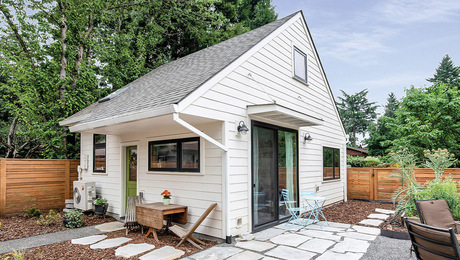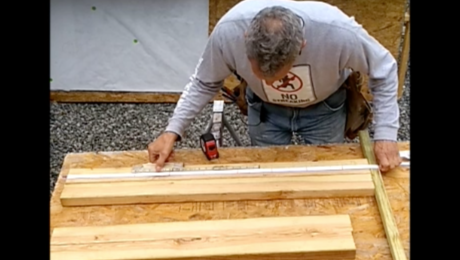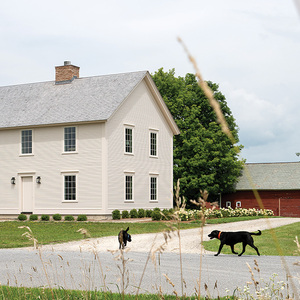Our new home in New England is almost completely framed and we are hoping to have the roof on within a couple of weeks. We are planning on using spray foam insulation. I was recently told that spraying the roof deck is preferrable to putting down plywood on the attic floor and spraying the underside of the plywood This doesn’t make sense to me because it would seem I am adding conditioned space ( more to heat) and the roof is going to get hotter if the foam is up against the roof sheathing. I know this is done on cathedral ceilings but I always believed a cooler roof will last longer.
Also- considering the high cost of spray foam it occurs to me that I would be better off taking advantage of my extra deep ceiling joist ( 12″) and using either fiberglass or a blown in insulation.
Thanks in advance for any help and opinions.
RMB



















Replies
In that situation i think I would air seal and go with cellulose on the attic floor, but if you want to use the attic for storage, or possibly as a future finished room, I would spend the extra money for foam. You could net and blow the rafters with cellulose as well, although the foam will perform better in that situation.
I personally vote for hot roof/cool attic, but there is still a lot of difference of opinion out there.
Edited 8/11/2008 7:12 pm ET by remodelman
Thanks- the attic isn't usable space so I am still leaning toward insulating the ceiling.
RMB
For NE, I lean to insulating the ceiling.
As for the combination approach, one of the great advantages of having a home insulated with spray foam is the absolute control of infiltration/exfiltration. but if you do not spray the ceiling or the sills, you lose that advantage. one option for a hybrid system that could help is to install Thermax on the bottom of the ceiling joists, tape the seams and can foam at other penetrations, then strapping to hang the sheetrock to.
Now you can blow the cells above the foam panel.
Welcome to the
Taunton University of Knowledge FHB Campus at Breaktime.
where ...
Excellence is its own reward!
One detail: It takes no additional heat to heat a larger VOLUME. What costs you is the external AREA you heat. Insulating the roof does add a slight additional area compared to insulating the ceiling (how much depends on roof slope). For a 12/12 pitch it increases the area by about 1.4.
Including the attic in the "conditioned space" may make sense if you have ductwork there. Otherwise the ductwork must be carefully sealed and insulated. Also, if the attic is conditioned you have fewer issues with wire and pipe penetrations into the attic.
But blown-in cellulose is cheap and has an excellent track record. Generally you'll want more than 12 inches, though, depending on where exactly you live in New England.
DanH took the words out of my mouth. The insulators may be suggesting that you foam the underside of the roof because you have ductwork and lots of penetrations running in the attic. By bringing the attic into the conditioned space, you are eliminating the need for all the duct insulation and air sealing of chases, penetrations, and weak spots in the attic floor. This especially makes sense if you think you will ever convert the attic to useable living space.
Everybody's situation is different, maybe your attic has no ducts,etc - and will never be used for living space because of a low pitch roof or something along those lines - you would need to offer more about your situation, or ask the insulation contractor why he/she's suggesting this approach.
Justin Fink - FHB Editorial
...oh, and I agree with you. Spray foam is great for some areas, but I think an attic floor might be a place where you could comfortably rely on fiberglass or cellulose in it's place. But if you are insulating the underside of the roof, the foam may be the better choice.Justin Fink - FHB Editorial
I guess I'm old school, but I have always put some air below the sheathing. I am still not sold on the foam the rafter space idea esp. when remo-ing older homes. Doesn't the roof and sheathing need some air-moisture movement??
<<
<<I guess I'm old school, but I have always put some air below the sheathing. I am still not sold on the foam the rafter space idea esp. when remo-ing older homes. Doesn't the roof and sheathing need some air-moisture movement?? >>
I doubt you are the only one who feels this way. All I can say is that the science behind it seems to show that it's ok to foam right up to the underside of the roof sheathing. The insulation is thick/effective enough that the dewpoint won't cause problems with condensation, thus no need to worry about moisture or airflow between insulation and sheathing. Justin Fink - FHB Editorial
Moisture is one thing, heat is another. I can't believe it is good for shingles or plywood sheathing to cook in a hot sun. Foam on the underside of the plywood will cause the roof to get HOT!
Thanks to all for the replies.
RMB
Rockmanblue
Piffin has given you good advice if you're shaving pennies on insulation costs.
I took a differant approach since the cost of heat is going up and unlikely to be an insignificant portion of the cost of owning a home in the future..
I had foam on the floor of my attic (R50) then in the rafters of my attic I put fiberglas insulation as a sort of belt and suspenders approach. What that gave me is an attic warm enough to play in or search for stuff stored away on the coldest day. Any heat lost thru the R 50 would be retained by the fiberglas.
It works the opposite on hot summer days.. my attic isn't hot or stiffing and my whole house feels a lot cooler.. I've used my air conditioners only 2 days this summer in spite of temps in the high 80's-90's with near 100% humidity